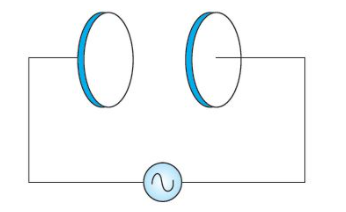An em wave going through vacuum is described by E=E0sin(kx−ωt)
B=B0sin(kx−ωt)
E0=B0
E0ω=B0k
E0B0=ωk
E0k=B0ω
The correct Answer is:D
Step by step video, text & image solution for An em wave going through vacuum is described by E=E_0sin(kx-omegat) B=B_0sin(kx-omegat) by Physics experts to help you in doubts & scoring excellent marks in Class 12 exams.
Updated on:21/07/2023Topper's Solved these Questions
- ELECTRO MAGNETIC WAVESBook:NARAYNAChapter:ELECTRO MAGNETIC WAVESExercise:LEVEL -I(C.W.)
Explore 21 Videos
- ELECTRO MAGNETIC WAVESBook:NARAYNAChapter:ELECTRO MAGNETIC WAVESExercise:LEVEL- II (C.W.)
Explore 15 Videos
- ELECTRO MAGNETIC WAVESBook:NARAYNAChapter:ELECTRO MAGNETIC WAVESExercise:LEVEL-II(H.W)
Explore 14 Videos
- ELECTRO MAGNETIC INDUCTIONBook:NARAYNAChapter:ELECTRO MAGNETIC INDUCTIONExercise:Level-II (H.W)
Explore 23 Videos
- ELECTROMAGNETIC INDUCTIONBook:NARAYNAChapter:ELECTROMAGNETIC INDUCTIONExercise:ASSERTION & REASON
Explore 6 Videos
Similar Questions
A parallel plate capacitor made of circular plates each of radius R=6.0 cm has a capacitance c=100pF. The capacitor is connected to a 230VAC supply with a ( angular) frequency of 300rad/s
(a) What is the rms value of the conduction current ?
(b) Is the conduction current equal to the displacement current?
(c) Determine the amplitude of B at a point 3.0cm from the axis between the plates.
 .
.
View SolutionA parallel plate capacitor consists of two circular plates each of radius 2cm, separated by a distance of 0.1mm. Ifvoltage across the plates is varying at the rate of 5×1013V/s, then the value of displacement current is :
View SolutionThe area of each plate of parallel plated condenser is 144cm2. The electrical field in the gap between the plates changes at the rate of 1012Vm−1s−1. The displacement current is
View SolutionA coil of 30 turns of wire each of 10cm2 area is placed with its plance perpendicular to a magnetic field of 0.1T. When the coil is suddenly withdraw from the field, a galvanometer connected in series with the coil indicated that a 10μC charge passes around the circuit. The combined resistance of the coil and galvanometer is
View SolutionAssertion: Magnetic flux is a vector quantity
Reason: Vlaue of magnetic flux can be positive, negative or zero
View SolutionAn electromagnetic wave going through vacuum is described by E= E_0 sin(kx- omega t), B=B_0sin(kx-omega t) . Then
View SolutionWhich of the following equations can form stationary waves? (i) y= A sin (omegat - kx) (ii) y= A cos (omegat - kx) (iii) y= A sin (omegat + kx) (iv) y= A cos (omegat - kx) .
View SolutionAn em wave going through vacuum is described by E=E0sin(kx−ωt)
B=B0sin(kx−ωt)
View SolutionAn e.m. wave going through vacuum is denoted by E=E_0sin(kx-omegat) . Which of the following is /are independent of wavelength?
View SolutionIf the waves of the form y=asin(ωt−kx) nad y=acos(kx−ωt) are superposed, the resultant wave will have amplitude
View Solutionनिर्वात में संचारित विधुत-चुम्बकीय क्षेत्र को निम्नलिखित समीकरणों से व्यक्त किया जाता है-
E=E0sin(ωt−kx),B=B0sin(ωt−kx), तब
View Solutionप्रगामी तरंग y1=Asin(ωt−kx) तथा अन्य प्रगामी तरंग y2=Asin(ωt+kx) अध्यारोपित होती हैं। परिणामी है :
View SolutionAn em wave going through vacuum is described by E=E0sin(kx−ωt)
B=B0sin(kx−ωt)
View SolutionA electromagnetic wave going through a medium is given by E = E_(0)sin (kx – omegat) and B = B_(0) sin (kx – omegat) then
View SolutionAn electromagnetic wave going through vacuum is described by E=E0sin(kx−ωt) which of the following is/are independent of the wavelength ?
View Solutionनिर्वात में से जा रही वैद्युतचुम्बकीय तरंग, E=E0sin(kx−ωt) से दर्शाई जाती है। निम्न में से क्या तरंगदैर्ध्य पर निर्भर नहीं?
View Solution
